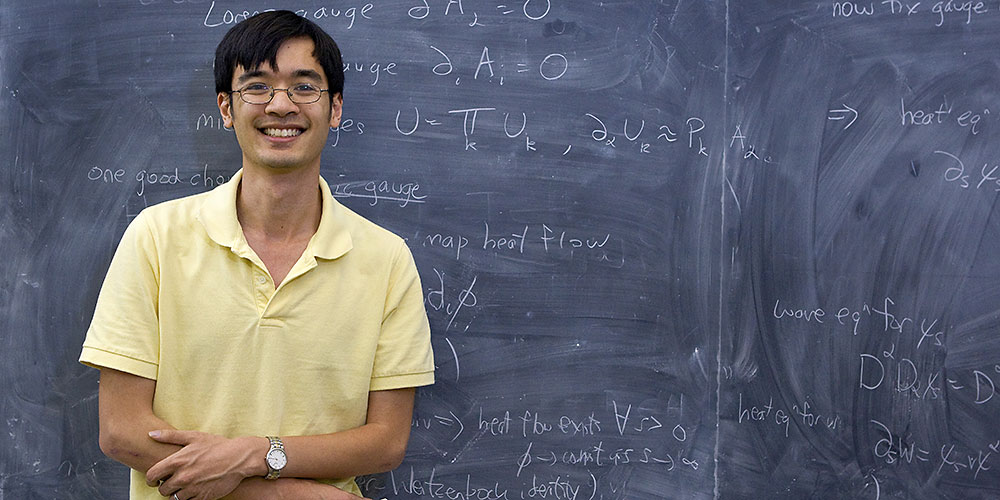
Three years later, at age 10, Tao became the youngest person in history to win a medal in the International Mathematical Olympiad. (Tao taught himself to read at age 2.)Ī few months later, halfway through the school year, Tao was moved up to 12th-grade math.

His teacher told the reporter that he hardly taught Tao anything, because Tao was always working two lessons ahead of the others. An old headline in his hometown paper, The Advertiser, reads: ‘‘TINY TERENCE, 7, IS HIGH-SCHOOL WHIZ.’’ The clipping includes a photo of a diminutive Tao in 11th-grade math class, wearing a V-neck sweater over a white turtleneck, kneeling on his chair so he can reach a desk he is sharing with a girl more than twice his age. At the room’s other end stood a fiberboard bookcase haphazardly piled with books, including ‘‘Compactness and Contradiction’’ and ‘‘Poincaré’s Legacies, Part I,’’ two of the 16 volumes Tao has written since he was a teenager.įame came early for Tao, who was born in South Australia. The couch had been pulled away from the wall to accommodate the beat-up Trek bike he rides to work.

Behind him, a small almond couch faced a glyph-covered blackboard running the length of the room. Thin and unassuming, he was dressed in Birkenstocks, a rumpled blue-gray polo shirt and jeans with the cuffs turned up. Tao, who is 40, sat at a desk by the window, papers lying in drifts at the margins. And in the process, he will have also solved the Navier-Stokes global regularity problem, which has become, since it emerged more than a century ago, one of the most important in all of mathematics. But, Tao explained, if he can show mathematically that there is nothing, in principle, preventing such a fiendish contraption from operating, then it would mean that water can, in fact, explode. It was merely a thought experiment, of the sort that Einstein used to develop the theory of special relativity. Now imagine, he went on, that this machine were able to make a smaller, faster copy of itself, which could then make another, and so on, until one ‘‘has infinite speed in a tiny space and blows up.’’ Tao was not proposing constructing such a machine - ‘‘I don’t know how!’’ he said, laughing. As he talked, Tao carved shapes in the air with his hands, like a magician. It would be built not of rods and gears but from a pattern of interacting currents. Imagine, he said, that someone awfully clever could construct a machine out of pure water. It’s a decades-old conundrum, and Tao has recently been working on an approach to a solution - one part fanciful, one part outright absurd, like some lost passage from ‘‘Alice’s Adventures in Wonderland.’’ And yet, Tao explained, nobody can say precisely why. A widely used set of equations describes the behavior of fluids like water, but there seems to be nothing in those equations, he told me, that prevents a wayward eddy from suddenly turning in on itself, tightening into an angry gyre, until the density of the energy at its core becomes infinite: a catastrophic ‘‘singularity.’’ Someone tossing a penny into the fountain by the faculty center or skipping a stone at the Santa Monica beach could apparently set off a chain reaction that would take out Southern California. Along with teaching, he is also a part of ‘Analysis Group’ at UCLA, and editor of various mathematical journals.This April, as undergraduates strolled along the street outside his modest office on the campus of the University of California, Los Angeles, the mathematician Terence Tao mused about the possibility that water could spontaneously explode. In addition to this, he is teaching at the Department of Mathematics at UCLA.

Currently, he is focusing on different branches of mathematics such as geometric combinatorics, harmonic analysis, partial differential equations, algebraic combinatorics, arithmetic combinators, compressed sensing and analytic number theory.

Tao has won a number of awards and has authored various books over the years. He is known for his and notable works such as ‘Green-Tao theorem’, ‘Tao’s inequality’, ‘Kakeya Conjecture’ and ‘Horn Conjecture’. Tao and another mathematician, Lenhard Ng are the only two people who have achieved a score of more than 700 in the SAT Math section. Tao’s interest in mathematics developed from childhood, and he has achieved success because of his work ever since he was 10 years of age. He is a recipient of ‘Fellow of the Australian Academy of Science’ and ‘Fellow of the Royal Society’. Terence Tao is an Australian- American mathematician who has contributed enormously to the field of mathematics.


 0 kommentar(er)
0 kommentar(er)
